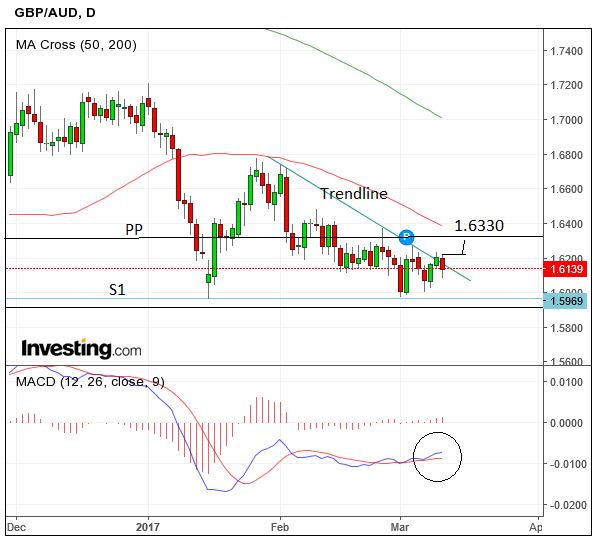GBP/AUD Exchange Rate Forecast for the Coming Week: Expecting More Upside

The Pound to Australian Dollar exchange rate has temporarily broken above the trendline drawn down from the February highs, in a mildly bullish move.
At the time of writing the pair is quoted at 1.6125.
Assuming the rate can re-break above the highs of the initial breakout at 1.6239 we foresee a continuation up to 1.6330 which is both a rough target for the break and a level just below the monthly pivot.
Monthly pivots are levels which act as substantial barriers to the trend and progress above 1.6330 will likely be hard going.
The MACD, which was going sideways, has pocked above the signal line and has the look and feel of a line poised to rise – another bullish indication.
Therefore, overall we are biased to see expect more upside from the pair.

Direction in the Australian Dollar will largely be determined by the release of employment data on Thursday, March 16 at 00.30.
Market expectations are for the Unemployment Rate to remain at 5.7% and there to be a 16.5k rise in payrolls.
Analysts at TD Securities are tilted towards expecting a slightly more robust figure of 25k new jobs although still expect unemployment to remains at 5.7%.
“We pencil in +220k in raw terms, after seasonal adjustment is +25k. Annual growth edges higher to +1.2% y/y, consistent with job vacancies. We see unchanged 64.6% participation rate and 5.7% unemployment rate. Look for a pickup in full-time hours worked to support our RBA Nov hike call," say TD Securities in a note seen by Pound Sterling Live.
As noted they are looking for an full-time employment which has been overshadowed by part-time employment gains to support s change in monetary policy orientation, which would see a rise in the Australian Dollar.
Direction in Pound Sterling will largely rest with the outcome of the monthly Bank of England (BoE) meeting due to be held on March 16 at 12.00 GMT.
Although no-change in policy is expected, the minutes which are released at the same time as the decision, will show how members deliberated on monetary policy issues.
Whilst some commentators had seen the BoE moving towards a tighter monetary policy stance - i.e. looking to raise interest rates, something that is supportive of Sterling - but this has probably changed since the spring Budget statement.
There is now a heightened possibility that the BoE will have to keep monetary policy expansive and interest rates low due the Chancellor’s fiscally tight budget, in which he gave away only 3bn in stimulus, according to Jonathan Loynes at Capital Economics.
“Fiscal policy is still set to provide a significant drag on GDP growth over the next few years – very similar to that planned in the Autumn Statement. As such, the onus will remain on monetary policy to support the economy,” says Loynes in a note seen by Pound Sterling Live.
Such a policy will keep the pressure on Sterling, particularly versus the Dollar where interest rates are contrastingly set to rise.
On the ‘hard’ data front, the main release for Sterling is labour market data on Wednesday March 15, although the unemployment rate is not expected to change from the current 4.8%.
Average Earnings are forecast to slip to 2.4% from 2.6% previously and the Claimant Count to go down by 5.0k from -42.5k previously.
Any improvement on those figures could give the Pound to Euro exchange rate a mid-week fillip.





